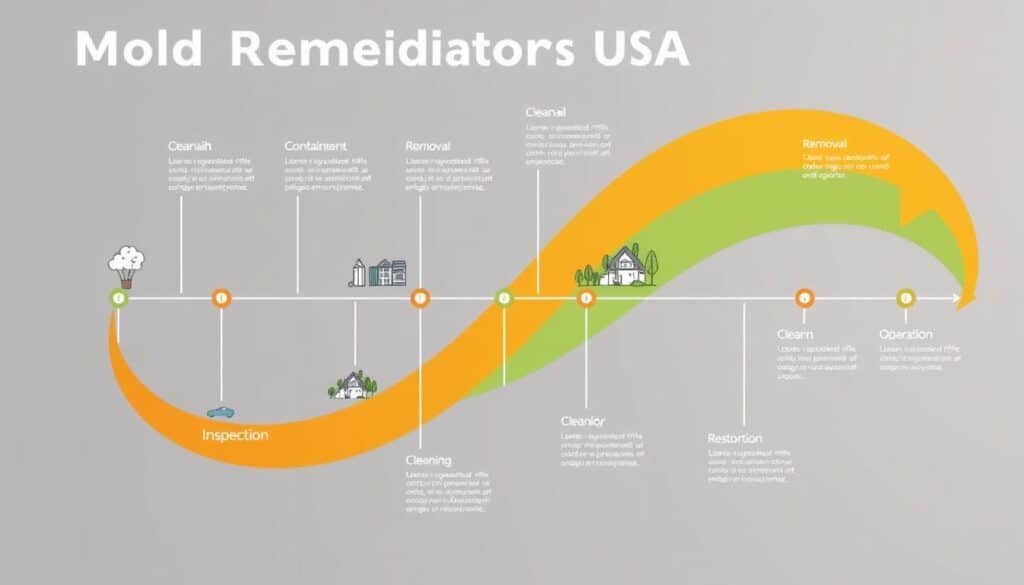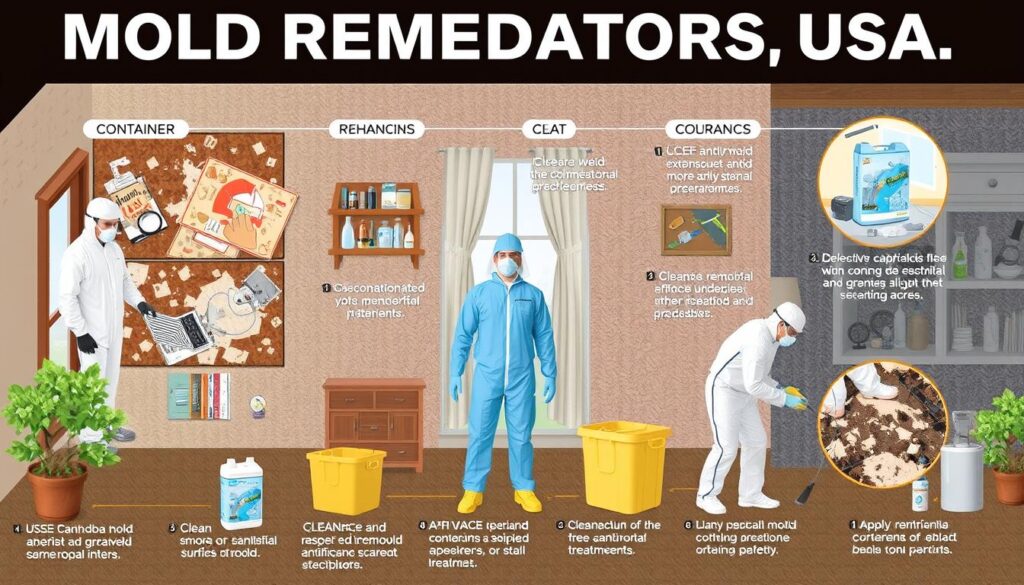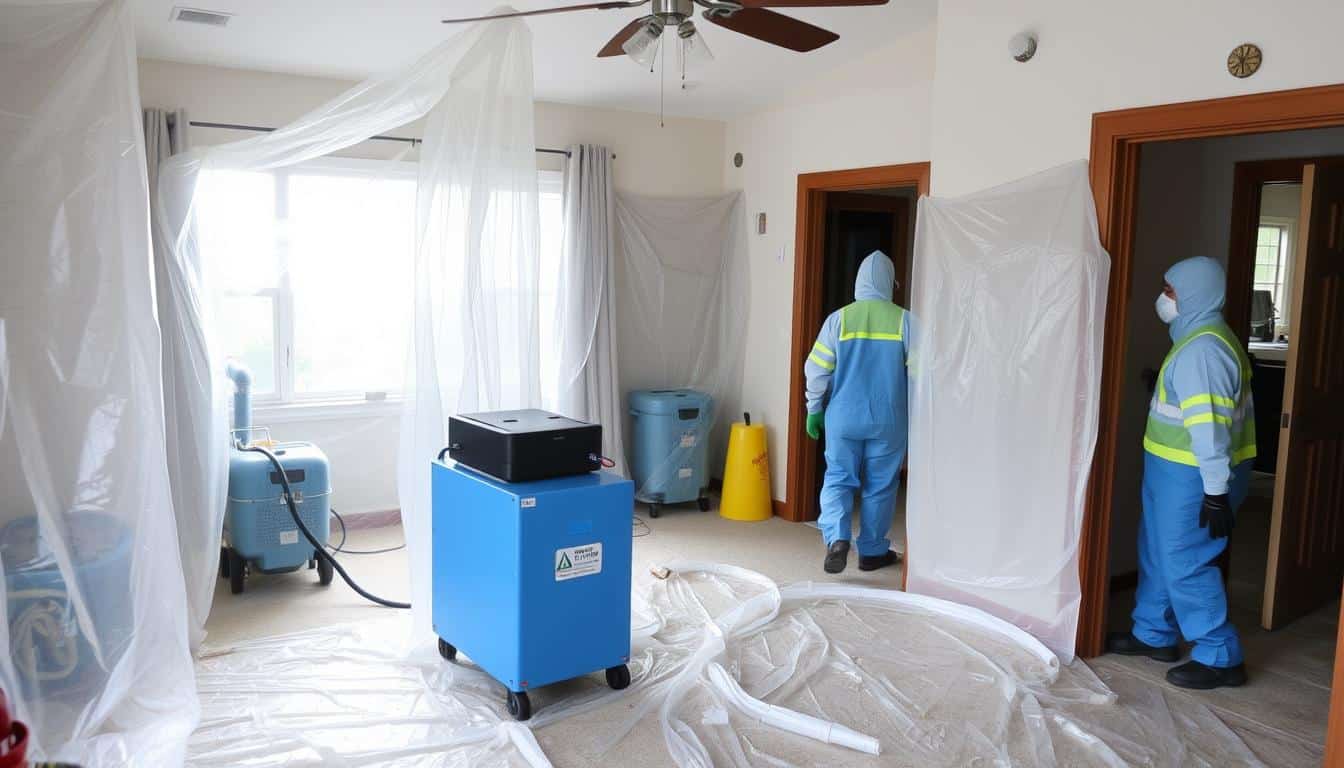Did you know mold remediation can take 1 to 5 days? This depends on how bad the mold infestation is. Understanding the mold remediation process, how long it takes, and why it’s important is key.
The Environmental Protection Agency (EPA) says to keep indoor humidity between 30-50% to stop mold. This shows how important controlling moisture is in preventing mold. When mold does grow, cleaning it up is more work than many think.
Mold remediation is more than just removing visible mold. It involves many steps like assessment, planning, and restoration. Each step is crucial for getting rid of mold and keeping it away.
The time it takes to fix mold problems varies. It depends on the area affected, how bad the mold is, and the surfaces involved. Big mold problems might take days to a week to fix. After fixing, drying and dehumidifying can take another 1 to 3 days.
Professional mold remediation services are usually better. They have the skills, tools, and materials needed. They not only remove mold but also fix the moisture issues to stop it from coming back.
Key Takeaways
- Mold remediation can take 1 to 5 days, depending on infestation severity
- Indoor humidity should be kept between 30-50% to prevent mold growth
- The process includes assessment, planning, remediation, and restoration
- Post-cleanup drying and dehumidification typically takes 1 to 3 days
- Professional services are often more efficient and effective
- Addressing moisture sources is crucial for preventing mold recurrence
Understanding Mold Remediation
Mold remediation is key to stopping mold growth and keeping it away. It usually takes one to five days. This depends on the area size and any dangers.
Definition of mold remediation
Mold remediation means finding and fixing moisture, sealing off the area, removing bad stuff, and cleaning well. It starts with an inspection, then setting up a containment area. Next, it involves removing mold with special tools and safe chemicals.
Importance of professional mold remediation
Getting pros for mold removal is crucial for big problems. DIY might save money, but it can miss mold, not remove it well, and be risky for health. Experts cost about $99 an hour, and more people are needed for big jobs.
Common causes of mold growth
Mold loves damp places. It grows from water damage, too much humidity, bad air flow, and leaks. Experts find and fix these to stop mold.
| Aspect | Duration | Cost |
|---|---|---|
| Mold Remediation | 1-5 days | $99/hour (average) |
| Mold Inspection | Varies | $300-$1,000 |
Knowing the mold removal plan is important for homeowners. Even though it costs a lot upfront, the benefits of professional help are worth it. It avoids incomplete removal and health risks.
Factors Affecting Mold Remediation Duration
The time it takes to fix mold problems depends on several factors. The size of the mold area is a big factor. Small areas under 10 square feet usually take 1-2 days to fix. Areas between 10-100 square feet might take 2-5 days.
Big mold problems over 100 square feet can take 1-2 weeks or more.
The type of mold also affects how long you’ll have to leave your home. Health risks from mold spores often mean staying away for 24-48 hours. Sometimes, this time can go up to 48-72 hours.
Fixing the reasons for mold growth, like moisture or bad air flow, adds time to the process. The more complex the mold problem, the longer it takes.
Professionals usually finish mold removal in about a week. This includes drying, cleaning, and rebuilding. But, doing it wrong can cause mold to come back, so it’s best to get experts.
It’s key to check if the mold is gone after fixing it. I always say wait until tests show it’s safe.
How Long Does Mold Remediation Take?
The time it takes to remove mold can vary a lot. I’ve seen it take from 48 hours for small problems to weeks for big ones.
Average Timeframes for Different Scenarios
Most mold jobs take one to five days. For small issues, it can be done in 48 hours. But, serious cases like black mold might take up to two weeks.
Factors that May Extend Remediation Time
Several things can make mold cleanup take longer:
- Hidden mold behind walls or in hard-to-access areas
- Structural damage needing repairs
- Severe mold species needing intensive safety measures
- Extensive contamination affecting multiple areas
In extreme cases, mold can damage buildings a lot. This can cause ceilings to collapse, floors to cave in, and walls to crumble. Such damage might need replacing wooden parts, making the cleanup take even longer.
Expediting the Mold Remediation Process
To make mold removal faster, acting quickly is key. Quick action is important because mold spores can harm health if not treated. Professional mold remediation services use the latest methods and tools to quickly stop and remove mold. These experts are trained to handle all kinds of mold problems safely and effectively.
Fixing leaks, improving air flow, and controlling humidity are key to keeping mold away. These steps help keep your place mold-free after the cleanup is done.
The Mold Remediation Process: Step by Step
I’ll guide you through the mold removal process. It usually takes one to five days, based on how bad the mold is.

The first step is a detailed inspection. Experts check for moisture, air quality, and find where the mold started. This is key because mold grows in damp places and spreads fast if not stopped.
Then, the area with mold is sealed off. This stops mold spores from spreading to other parts of the building. Air filters are also used to catch spores during the cleanup.
The next step is removing things like carpeting and drywall that can’t be saved. Then, non-porous surfaces are cleaned with special cleaners and HEPA vacuums to get rid of spores.
After cleaning, the area is dried to stop mold from coming back. Professional mold removal makes sure the humidity inside is low, which mold doesn’t like.
The last steps are fixing and restoring the area. This might mean painting, replacing drywall, or rebuilding damaged parts. A final check is done to make sure everything is okay, including moisture and air quality.
By following this detailed mold removal plan, experts can get rid of mold and keep it from coming back. This makes homes healthier for everyone.
Mold Assessment and Inspection
Mold assessment is key in fixing mold problems. I’ll show you how experts use special techniques to find and check mold issues.
Visual Inspection Techniques
The first step is a detailed look around. I search for mold, water damage, and where water might be getting in. This part can take 1 to 2 hours, based on the place’s size and how complex it is.
Moisture Detection Methods
To find hidden mold, I use special tools. Moisture meters and infrared cameras help spot where it’s humid. Mold likes it when it’s 30% to 50% humid, so finding these spots is important.
Mold Testing and Sampling
The last step is testing and sampling. I take air and surface samples to send to the lab. This usually takes 1 to 3 days, from when I collect the samples to when I get the results. I compare indoor air samples with outdoor ones to see how much mold there is.
I also test the HVAC system with a swab sample. This thorough method makes sure we don’t miss any mold. The whole mold assessment, from looking around to testing, usually takes 1 to 3 days.
Containment and Preparation
I know that effective mold containment procedures are crucial for successful mold remediation. The first step in mold remediation preparation is isolating the affected area. This involves using plastic sheeting to create a barrier, preventing mold spores from spreading to uncontaminated spaces.
Setting up negative air pressure is another key aspect of containment. This process ensures that air flows into the contaminated area rather than out, further limiting the spread of mold spores. Air filtration devices play a vital role in this stage, capturing airborne spores and improving air quality.

The duration of the containment and preparation phase can vary. Small-scale mold remediation projects typically take one to five days to complete. For larger areas or cases with significant structural damage, the process might extend to a week or more. The preparation phase alone could take 1-2 days, depending on the size of the affected area.
During mold remediation preparation, I always ensure proper personal protective equipment for remediation workers. This includes respirators, gloves, and protective suits to safeguard against mold exposure. It’s also important to cover and protect unaffected areas to prevent cross-contamination.
| Project Scale | Estimated Duration | Additional Factors |
|---|---|---|
| Small-scale | 1-5 days | Limited affected area |
| Large-scale | 1 week or more | Significant structural damage |
| Multiple rooms | 1-2 weeks | Extensive contamination |
| Vacant properties | 2-3 weeks | Longer remediation time |
Remember, thorough containment and preparation are essential for effective mold remediation. These steps not only prevent further spread but also create a safe environment for the remediation process to take place.
Mold Removal and Cleanup
Mold removal techniques depend on the surface and how bad the infestation is. I’ve found that good mold cleanup methods are key to fixing the problem.
Techniques for Different Surfaces
For non-porous surfaces, antimicrobial solutions work well. But, porous materials might need to be replaced. Techniques like HEPA vacuuming, damp wiping, and sanding are used. The time needed varies – small spots might take 3 hours, while bigger areas can take up to 2 days.
Disposal of Contaminated Materials
Getting rid of contaminated materials is very important. All wet and moldy porous items should be taken out and put in sealed plastic bags for safe disposal. This step is key to stop more contamination and make sure everything is fixed.
Use of Antimicrobial Treatments
After removing mold, antimicrobial treatments are used to stop it from coming back. This, along with other steps like making barriers and using HEPA filters, helps finish the job in 2-3 days. The cleanup phase is important to make sure the area is clean and free of mold and debris.
Remember, how hard it is to remove mold can vary. Some jobs can be done in a day with the right tools. But, jobs like fixing mold in crawl spaces can take up to 10 days, depending on size and how easy it is to get to. Always put safety and thoroughness first in your mold cleanup work.
Post-Remediation Verification
After mold remediation, a key step is the post-remediation verification. This step checks if the cleanup was successful. It gives property owners peace of mind.
Inspection happens 24 to 48 hours after mold work is done. It includes looking, checking moisture, and air quality tests. These steps confirm if the cleanup was effective.
Inspectors look for any leftover water damage or mold. They use tools like moisture meters and infrared cameras to find hidden moisture. They also test the air to see if mold spores are present.
In Texas, mold work is watched by the Texas Department of Licensing and Regulation. Licensed contractors must give a Certificate of Mold Damage Remediation within ten days. This certificate proves the mold problem was fixed.
The mold clearance testing makes sure the cleanup meets the Mold Remediation Protocol standards. After a successful check, a detailed report is given to everyone involved. This report confirms the mold problem was solved.
By following these strict steps, property owners can be sure their mold issues are gone. This makes their living space safer and healthier.
Preventing Future Mold Growth
After fixing mold, it’s important to stop it from coming back. I’ll share ways to keep your home mold-free.
Moisture Control Strategies
Stopping moisture is key to preventing mold. Fix leaks fast and use dehumidifiers in wet spots. Also, make sure water drains well around your home. Mold needs water, air, food, and humidity to grow inside.
Improving Ventilation and Air Circulation
Good air flow helps stop mold. Put in exhaust fans in bathrooms and kitchens. Open windows when it’s nice outside. Air purifiers can also help by removing mold spores from the air. It’s best to keep indoor mold counts under 500 spores per cubic meter to stay healthy.
Regular Inspections and Maintenance
Spotting mold early is key. Check your home often, especially where moisture is common. Clean gutters and watch for water getting in. Also, keep your HVAC system in good shape. The EPA says catching mold early and acting fast is important to stop it from spreading.
Using these prevention tips can greatly lower the chance of mold coming back. Remember, fixing mold can cost between $1,100 and $3,300. So, preventing it is not only better for your health but also saves money.
Stay alert and fix any moisture problems right away. With these steps, you’ll make your home healthier and avoid future mold problems.
Conclusion
I’ve learned that fixing mold is a big job with different times needed. It can take a few days or weeks, depending on many things. Experts usually follow a set plan, starting with checking, then stopping it, removing it, cleaning up, and drying.
The size of the mold problem affects how long it takes to fix. Big areas need more time and effort to get right. Things like humidity and temperature also play a part in how fast mold grows and gets fixed.
New methods are helping make mold fixing faster. For example, Dry Fog Technology can do it in just four hours. This is much quicker than the usual seven days needed to remove bad materials. It’s important to deal with mold quickly to avoid health problems, as the CDC says.
In short, fixing mold takes time, but it’s key for a healthy home. Knowing what affects the time helps homeowners get ready for the process in their homes.
FAQ
What is mold remediation?
Mold remediation is the process of dealing with mold growth. It includes finding and fixing moisture sources. Also, it involves containing the area, removing contaminated materials, and cleaning and drying the space.
Why is professional mold remediation important?
Professional mold remediation is key for tackling big mold problems. It ensures the area is properly cleaned and sealed. This helps stop mold spores from spreading and reduces health risks.
What are the common causes of mold growth?
Mold grows due to water damage, high humidity, bad ventilation, and leaks. These can be in plumbing or roofing.
How long does mold remediation typically take?
Mold remediation time varies. It can take from one to five days. This depends on the area size, infestation severity, and surface types.
What factors can extend the mold remediation timeline?
Several factors can make remediation take longer. These include hidden mold, structural damage, or special treatments needed. Big infestations, porous materials, and toxic mold also slow the process.
How can the mold remediation process be expedited?
To speed up, act quickly, contain the area well, and use advanced techniques and tools.
What are the steps involved in the mold remediation process?
The steps include assessing and inspecting first, then containing the area. Next, remove contaminated materials, clean and disinfect, dry and dehumidify, and do final testing.
How is mold assessed and inspected during remediation?
Mold assessment starts with a visual check. It’s often helped by moisture meters, infrared cameras, and tests like air and surface sampling.
What is involved in the containment and preparation phase?
Containment means isolating the area with plastic and negative air pressure. Set up air filters, cover other areas, and use proper gear.
How are different surfaces treated during mold removal and cleanup?
Non-porous surfaces get cleaned with antimicrobial solutions. Porous materials might need removal and replacement. Cleaning methods include HEPA vacuuming, damp wiping, and sanding.
What is involved in post-remediation verification?
Verification checks if mold is gone and moisture is controlled. It includes a final inspection, moisture checks, and air or surface sampling. A third-party inspector often does this.
How can future mold growth be prevented?
To prevent mold, fix moisture problems, improve air flow, and use dehumidifiers. Keep the property dry and do regular checks and maintenance.




